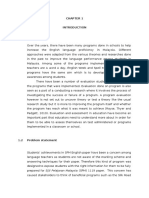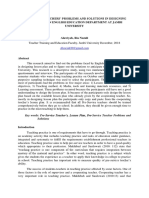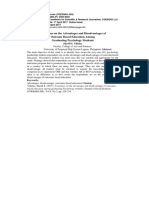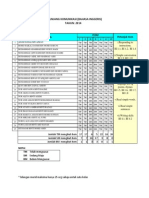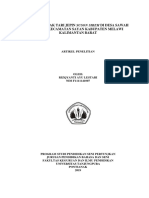Name: Hafifah Binti Kusin MATRIC NUMBER: 2020.8.EDU02.002: Article Review
Name: Hafifah Binti Kusin MATRIC NUMBER: 2020.8.EDU02.002: Article Review
Uploaded by
Pipah KusinCopyright:
Available Formats
Name: Hafifah Binti Kusin MATRIC NUMBER: 2020.8.EDU02.002: Article Review
Name: Hafifah Binti Kusin MATRIC NUMBER: 2020.8.EDU02.002: Article Review
Uploaded by
Pipah KusinOriginal Title
Copyright
Available Formats
Share this document
Did you find this document useful?
Is this content inappropriate?
Copyright:
Available Formats
Name: Hafifah Binti Kusin MATRIC NUMBER: 2020.8.EDU02.002: Article Review
Name: Hafifah Binti Kusin MATRIC NUMBER: 2020.8.EDU02.002: Article Review
Uploaded by
Pipah KusinCopyright:
Available Formats
ARTICLE REVIEW
Base on the article provided, state your opinion on the effectiveness of School Based
Assessment.
NAME: HAFIFAH BINTI KUSIN
MATRIC NUMBER: 2020.8.EDU02.002
COURSE/PROGRAME: MASTER OF EDUCATION (MED)
SUBJECT: EDUCATIONAL ASSESSMENT (EDA 1130)
LECTURER: DR AHMAD ZULFADHLI KHAIRUDDIN
Nor Hasnida Che Md Ghazali, “The implementation of School-Based Assessment
System in Malaysia: A study of teacher perceptions”, GEOGRAFIA Online Malaysian
Journal of Society and Space, 12 issue 9 (104 – 117), 2016.
Abstract
The article, “Implementation of School -Based Assessment System in Malaysia: A study on
teacher perceptions”, by Nor Hasnida Che Md Ghazali was to evaluate the implementation of
SBA in schools in preparing a summative report on the effectiveness of this system as it has
always been an increasingly important impact for middle school students. countries like
Malaysia. The authors argue that the school -based assessment system is a holistic assessment
system in line with the National Philosophy of Education. The authors conducted their own
study of 776 primary and secondary school teachers by the Daniel Stufflebeam CIPP
assessment format. The study has been conducted for almost two years. The results show that
the system has a relationship between three dimensions (inputs, processes and products).
Overview
In her writing, the author states that it has become a trend in the assessment system is now
changing to formative assessment in some countries. A large number of literatures on
formative assessment comes from developed countries because they have done it long ago. In
Australia SBA was started in the late 1960s (Mercurio, 2008) and in Finland as well as
Sweden, its implementation was started in the early 1970s (Darling-Hammond and
McCloskey, 2008). The authors found that, research about the SBA is not yet widespread.
Most research is focused on the evaluation process itself, including the attitudes of teachers
(Majid, 2011), or an assessment of the system itself that is identified interest SBA (Mansor et
al. 2003). Up to now there has been no study related to the fourth dimension SBA
assessment.
CIPP Model
The CIPP model has been used to evaluate various educational programs and projects from
various disciplines (Stufflebeam, 2003). CIPP contains four components namely context
(what needs to be done), input (how it should be done), process (how it should be done) and
outcome (whether it works). The main purpose of this evaluation is made to relate the goals,
context, inputs and processes to the outcomes of the program. In addition to determine the
suitability of the environment in helping to achieve the goals and objectives of the program.
This CIPP also aims to improve a program and not to prove the truth. Therefore, the CIPP
model is widely used by researchers including authors in evaluating the effectiveness of
programs and curricula in institutes of higher learning in and outside the country.
This CIPP model has been designed for the purpose of improvement as well as
decision making related to a course, program or curriculum (Ghazali, 2010; Singh, 2004;
Stuffllebeam & Shinkfield, 1985). Muhammad (1997) has used the CIPP model to evaluate
the effectiveness of the Diploma in Education program at the Faculty of Education,
University of Malaya through a qualitative study. Azizi (2001) has used the CIPP model to
evaluate the Life Skills Curriculum in Malaysian secondary schools. Using this model, she
has managed to identify some of the weaknesses and strengths of a variable in each
dimension. The results of the study were used to decide to continue the implementation of the
subject curriculum as well as some suggestions for improvement in the future. Based on these
arguments then it can be taken into account why the author uses CIPP in conducting his
research.
Based on the CIPP dimension, context assessment refers to the systematic process of
obtaining information about the setting of new program objectives or for translating needs
into objectives as well as modification or validation of existing objectives to guide decision
planning (Stufflebeam, 1971). This stage is very suitable for the formulation phase of a
training program (Reeves, 1994). Methods of collecting data for this purpose can be in the
form of surveys, interviews, document reviews (Dalkey and Helmer, 1963) or through focus
groups, websites, journals or standardized tests (Clinton, 2001). Input evaluation, on the other
hand, focuses on the planning, strategies, procedures and resources involved in helping to
achieve program goals and objectives (Stuffbeam et. Al, 2003; Ornstein & Hunkins, 2009).
Data for input assessment can be collected using surveys, interviews, websites or journals
with most of the data coming from existing documentation (Clinton, 2001).
The next step is process evaluation focused on program implementation (Stufflubeam
et al.2003; Ornstein & Hunkins, 2009). Evaluation of this process is important to see if what
is being implemented and what is planned. This information needs to be known from time to
time to control the implementation of the program. This is related to efforts to improve the
effectiveness of the program. Interviews are the best method of collecting data for process
evaluation. Product evaluation focuses on the results of the program after it is implemented.
This evaluation looks at whether the goals, objectives and learning outcomes of the course
are achieved at the end of the course. Product evaluation also looks at aspects of student
achievement including the number and percentage of passes and failures in either theory or
clinical competence.
The assessment system in the Malaysian educational context
An agreement was made by the Cabinet in a meeting on 17 December 2010 to make
improvements to the national assessment system. The general public is aware that the
assessment system in Malaysia is more geared towards public examinations. In 2011, the
SBA consisting of both assessment, formative and summative was formally implemented on
Year one students. Findings from the handbook issued by the Ministry of Education Malaysia
(MOE), have clearly explained that the implementation of SBA covers two main aspects of
assessment, namely the academic component (school and centre assessment) and non
-academic components (physical activity, sports, assessment, co -curriculum and
psychometric assessment). It is a form of assessment that is planned, administered, marked
and reported by the subject teacher according to the guidelines of the Malaysian
Examinations Board.
The present study
In this study, the authors made an assessment of the context of the changes involve two
factors; types of schools (urban and rural) and schools (primary and secondary). For the input
evaluation dimension, the authors have focused on the first three order factors namely the
material needs and personal needs of the SBA, the suitability of personal qualifications and
the suitability of physical and ICT infrastructure. While the dimensions of the assessment
process covers twelve factors of the first order; beliefs, feelings, readiness, understanding,
courses, internal training, administration, challenges, simplicity, monitoring, role and
importance of SBA. For product evaluation, it includes three factors, namely, the first order,
attitude, knowledge and motivation of students towards learning.
Methodology
The authors have used quantitative methods to help the exploration of the study in more
depth and comprehensively. Data collection was conducted through questionnaires and
document analysis. Sampling was taken at random. Selecting the background, population and
sample depends on the objectives and questions of the study (Othman, 2009). A total of 2500
questionnaires were distributed to respondents in primary and secondary schools in one of the
states in the northeast of Peninsular Malaysia. However, only 776 questionnaires were
obtained because there were many items that were not answered.
The number of samples collected was sufficient to apply the procedure of calculating
the probability of the mean standard error also known as the mean standard deviation (SEM;
Standard Error of the Mean). Dimensional relationships were analysed using SEM. SEM is
also capable of correcting measurement errors by providing error variance estimates that
cannot be calculated by traditional multivariate procedures (Byrne, 2010). The standard
deviation is considered to be one of the best spread measures, which measures the value
spread from the centre value. Standard error is used mainly to check the reliability and
accuracy of estimates and so on, the smaller the error, the greater is the reliability and
accuracy.
The questionnaire used was designed by the researcher based on the CIPP Model.
Researchers are more focused on instruments from Asian countries such as Hong Kong,
Singapore, Australia and Malaysia to ensure that the items are appropriate to the Asian
context. For the validity, reliability and practicality of the instrument then the researcher has
asked for the instrument to be certified by experts in horticulture and evaluation. Then
through a translation process and finally checked for reliability of its internal consistency,
followed by independent exploratory factor analysis (EFA) using primary component
analysis (PCA) with a rotation called Direct Oblimin performed on the questionnaire.
Independent exploratory factor analysis (EFA) was conducted to identify some factors
or components that exist in the set of questionnaires that have been formed. The objective of
factor analysis is to reduce the dimensions of the original data to a number of smaller
components and to be more easily and meaningfully interpreted (Duntemen, 1980; Lewis-
Beck, 1994 & Field, 2006). In statistics, main component analysis (PCA) is a technique used
to simplify a data, by transforming linearly so that a new coordinate system is formed with as
much as possible to maintain maximum data variance. Finally, the researcher was able to
produce 68 items out of 71 items.
The answers were collected through a distributed questionnaire, reviewed by
researchers and analysed using the Statistical Package for Social Science (SPSS). Of the 776
samples, 9 cases were removed and some items with low standard estimated values were also
eliminated. Finally, 38 items were retained and all six measurement models showed data
suitability, validity and reliability. Namely input dimension, process 1, process 2, process 3,
challenge and product dimension.
This study involves a two -stage approach to SEM analysis that includes evaluating
CFA and analysing SEM. So, of the six models that have been built earlier, some have been
eliminated. This is because all unimportant paths are eliminated one by one to examine the
best solution (Byrne, 2010). The elimination of constructs can alter the sample moment
concentration and degree of freedom, and subsequently cause large differences in X2 (Byrne,
2010). Finally, the structural model was then evaluated again with 26 variables.
Evaluation
Overall, the researcher’s findings indicate that the CIPP model is partly very helpful in
explaining the relationship between the evaluation dimensions in the SBA. The SEM results
also show that the model explains a fairly high variance. Among the attitudes and skills of
teachers also have a strong significance with the attitudes and motivations of students. When
teachers have a positive attitude and have skills in assessment, students ’propensity for
positive attitudes and students’ motivation can be enhanced. According to the researcher,
research conducted by ARG (2002), whenever several processes are implemented, such as
providing explanations of purpose and constructive feedback or developing students ’self
-assessment skills and criteria for learning, it can increase student motivation. Therefore,
these findings can confirm the previous study that the process is closely related to the
product.
The results of the analysis of this study successfully answer the question and the
purpose of this study. This study can provide some support on the effectiveness of SBA
implementation in schools. In addition, this study also supports the developed models namely
CIPP model, formative assessment model and SCAP model. However, this study only
involved teachers and did not involve students. This study also the data obtained are from the
perceptions of teachers without observing their actual practice. The study also found that
some items included in the survey were eliminated during the CFA and SEM procedures to
obtain a suitable model. Therefore, this study needs to be continued to obtain more
comprehensive findings on the effectiveness of SBA implementation in schools on teachers,
parents, students, administrators and any stakeholders. On the part of teachers, it is necessary
to make observations of their actual practice. Only then can a more accurate and in -depth
assessment of the implementation of the SBA be made.
Implication
Implications for this study that have been conducted, the researchers found that the strong
relationship between inputs and processes suggests that the resources and procedures
supplied to schools should support the effective implementation of SBA. The same goes for
process and product dimensions. However, researchers argue that administrators at the school
and ministry levels need to examine the inadequacy of the monitoring and moderation
process in ensuring a strong relationship with students ’attitudes and motivations. In the
quality assurance process set by the ministry, these two processes are very important.
Training should also be given to all teachers on this matter.
The implementation of this SBA can be seen to have the potential to move forward to
achieve a level of education comparable to developed countries. In the beginning there is
undeniably some drawbacks but when we look at something new from a positive angle
slowly, society will start to accept it when good results can be seen. Therefore, to further
strengthen this SBA, the implementers must be committed to their duties and responsibilities.
All parties must play their respective roles so that the implementation of this SBA has a
significant impact on the learning of today's children as intended by the MOE. The
development of teachers ’attitudes, skills and knowledge in formative assessment is by no
means a straightforward process and Heritage (2008) believes that these three components are
key components in implementing formative assessment effectively.
References
Azizi Hj. Yahaya. Penggunaan Model Kontek. Input, Proses, dan Produk (KIPP) dalam
Penilaian Program Pembelajaran. Sejauhmanakah ia relevan? International Conference
on challenges and Prospects in Teacher Education, Concorde Hotel Shah Alam. 16 & 17
July 2001
ARG (2002) Assessment for learning; 10 Principles. Assessment Reform Group, University
of
Cambrage.
Dalkey NC, Helmer O (1963) An experimental application of the Delphi method to the use of
experts. Management Science 9(3), 458-467.
Lembaga Peperiksaan Malaysia. (2014). Panduan Pengurusan Pentaksiran Berasaskan
Sekolah. Kementerian Pendidikan Malaysia.
Majid F (2011) SBA in Malaysian Schools: The Concern of the English Teacher. Jurnal of
US-
China Educatiaon, Review 8(10), 1-15.
Mansor AN, Ong HL, Rasul MS, Raof RA (2013). The Benefits of School-Based
Assessment.
Asian Social Science 9 (8), 101-106.
Mercurio A (2008) Re-imagining school-based assessment at the upper secondary level,
SACE Board of South Australia.
Othman Lebar. (2009). Penyelidikan Kualitatif. Selangor: Univision Sdn Bhd.
Scriven,M. (1967) The Methodology of Evaluation. In R.E. Stake (Ed.), AERA monograph
series on curriculum evaluation, No 1. Chicago: Rand McNally
Stufflebeam, D. L., Herold & Beulah, M. K. (2003). The CIPP Model for Evaluation. Annual
Conference of Oregon Program Evaluators Network (OPEN).
Stufflebeam, D.L. & Shinkfield, A. J. (1985). Systematic Evaluation. Boston: KluwerNijhoff.
Stufflebeam, D.L. (1971). Education Evaluation and Decision Making. Itasca, Illinois: F.E.
Peacock Publisher, Inc.
Stufflebeam. D.L. (1971). The relevance of CIPP evaluation model for educational
accountability. Journal of research and development in education 5(1): 19-25
Warju. (2015). Educational Program Evaluation using CIPP Model. Innovation of
Vocational
Technology Education. Invotec XII:1 (2016) 36-4.
You might also like
- Statistic Reviewer (Masters Degree)Document11 pagesStatistic Reviewer (Masters Degree)Japhet TendoyNo ratings yet
- 2021 Teacher Supply and Demand ReportDocument105 pages2021 Teacher Supply and Demand ReportRobyn Grace100% (1)
- Architecture in Use Summary of JM Van Der VoordtDocument43 pagesArchitecture in Use Summary of JM Van Der VoordtMiad F. Alhuwaydah100% (1)
- GROUP 4 MASEIS 4 Evaluation Study ProposalDocument19 pagesGROUP 4 MASEIS 4 Evaluation Study ProposalJENNY VERZOSANo ratings yet
- Warren A. Ramos: Impacts of Regional Training On Action Research Among Master TeachersDocument11 pagesWarren A. Ramos: Impacts of Regional Training On Action Research Among Master TeacherskristinebarredoNo ratings yet
- A Science Lesson Plan Analysis Instrument For Formative and Summative Program Evaluation of A Teacher Education ProgramDocument31 pagesA Science Lesson Plan Analysis Instrument For Formative and Summative Program Evaluation of A Teacher Education ProgramTiara Kurnia KhoerunnisaNo ratings yet
- Artikel InggrisDocument9 pagesArtikel Inggrisardhianjack19No ratings yet
- The CIPP Evaluation ModelDocument15 pagesThe CIPP Evaluation ModelJisha JanardhanNo ratings yet
- Curriculum Evaluation: Weeks 10 and 11Document39 pagesCurriculum Evaluation: Weeks 10 and 11April Rose Villaflor Rubaya100% (1)
- The Validity and Reliability of Assessment For Learning (Afl)Document6 pagesThe Validity and Reliability of Assessment For Learning (Afl)Nader ElbokleNo ratings yet
- Implementation of CIPP Model For Quality Evaluation at School Level: A Case StudyDocument18 pagesImplementation of CIPP Model For Quality Evaluation at School Level: A Case StudyOliver BernalesNo ratings yet
- CIPP Evaluation Model Scale: Development, Reliability and ValidityDocument8 pagesCIPP Evaluation Model Scale: Development, Reliability and ValidityRozahi IstambulNo ratings yet
- Unit 1 The Concept of Curriculum EvaluationDocument6 pagesUnit 1 The Concept of Curriculum EvaluationMoselantja MaphatsoeNo ratings yet
- Research Method and TechniqueDocument14 pagesResearch Method and TechniqueFaryal ShahidNo ratings yet
- Action Research PDFDocument25 pagesAction Research PDFChauncey CaballeroNo ratings yet
- Evaluating The Implementation Quality of A Social and Emotional Learning Program A Mixed Methods Approach-2020Document17 pagesEvaluating The Implementation Quality of A Social and Emotional Learning Program A Mixed Methods Approach-2020yil647No ratings yet
- Formative and Summative Assement ProposalDocument10 pagesFormative and Summative Assement Proposalhaidersarwar100% (1)
- Ped 06 Lesson 1Document70 pagesPed 06 Lesson 1barangaypugon.sfqNo ratings yet
- Sample Action ResearchDocument8 pagesSample Action ResearchHA MesNo ratings yet
- Research Proposal Tariq UpdatedDocument21 pagesResearch Proposal Tariq UpdatedFawad Khan WardagNo ratings yet
- Katuuk, 2014Document8 pagesKatuuk, 2014Didi PiandaNo ratings yet
- Thesis IntroDocument10 pagesThesis Intro0ppaiDaiskui 19No ratings yet
- Curriculum Thesis Mubshra 2-bDocument75 pagesCurriculum Thesis Mubshra 2-bstudyidea99No ratings yet
- ETEC 511 - Project Proposal (Alan Lam)Document2 pagesETEC 511 - Project Proposal (Alan Lam)Alan LimNo ratings yet
- Evaluasi Program Model Scriven - Sabana Asmi - 0403519015Document5 pagesEvaluasi Program Model Scriven - Sabana Asmi - 0403519015Sabana AsmiNo ratings yet
- ED 201 - Basic Inferential Statistics: Leah Mae L. Magana Final RequirementDocument5 pagesED 201 - Basic Inferential Statistics: Leah Mae L. Magana Final RequirementstarleahmaeNo ratings yet
- Without Referance ThesisDocument68 pagesWithout Referance Thesisstudyidea99No ratings yet
- Module 6 Curriculum EvaluationDocument5 pagesModule 6 Curriculum Evaluationreyma panerNo ratings yet
- Decision-Oriented Evaluation ApproachesDocument24 pagesDecision-Oriented Evaluation ApproachesQiblaHazoorNo ratings yet
- Ani Rindiani - JournalDocument13 pagesAni Rindiani - JournalPurnomo ipungNo ratings yet
- Assignment: Silk Road An EvaluationDocument35 pagesAssignment: Silk Road An EvaluationGrace RaymondNo ratings yet
- Review of Related Literatures and StudiesDocument6 pagesReview of Related Literatures and StudiesChristabelle Delos SantosNo ratings yet
- Evaluation of Physical Education Learning Program: Guntur@uny - Ac.idDocument16 pagesEvaluation of Physical Education Learning Program: Guntur@uny - Ac.iddown loadNo ratings yet
- New Journal SupervisionDocument7 pagesNew Journal SupervisionEshetu MandefroNo ratings yet
- Supervision and Performance Efficiency of Criminology InternsDocument34 pagesSupervision and Performance Efficiency of Criminology InternsCathlyn AngconNo ratings yet
- Ej1183343 PDFDocument16 pagesEj1183343 PDFMuhammad Aliff Abdul RahmanNo ratings yet
- ED514190Document24 pagesED514190nagaba nebertNo ratings yet
- Stuffle BeamDocument11 pagesStuffle BeamMichael Philip Cervantes100% (1)
- RRL Sa Chapter 2Document16 pagesRRL Sa Chapter 2HungryNo ratings yet
- The CIPP Model-Based Evaluation On Integrated English Learning (IEL) Program at Language CenterDocument10 pagesThe CIPP Model-Based Evaluation On Integrated English Learning (IEL) Program at Language CenterchenzNo ratings yet
- TSLB 3113 PresentationDocument21 pagesTSLB 3113 PresentationStephanie LimNo ratings yet
- Pre-Service Teachers' Problems and Solutions in Designing Lesson Plan in English Education Department at Jambi UniversityDocument10 pagesPre-Service Teachers' Problems and Solutions in Designing Lesson Plan in English Education Department at Jambi UniversityYola MaulidaNo ratings yet
- 2020_Dwi Hariyanti_The Higher Education Service Institutes (LLDIKTI) is a system of institutions formed by the Indonesian government to provide guidance to universities in its area. One of LLDIKTI's strengthening programsDocument8 pages2020_Dwi Hariyanti_The Higher Education Service Institutes (LLDIKTI) is a system of institutions formed by the Indonesian government to provide guidance to universities in its area. One of LLDIKTI's strengthening programsvchristieNo ratings yet
- Validity of Teacher-Made Assessment: A Table of Specification ApproachDocument8 pagesValidity of Teacher-Made Assessment: A Table of Specification ApproachRifkiNo ratings yet
- Extent of Implementation of Byahedukasyon of Camohaguin Elementary School During Pandemic: Basis For Program Enhancement and Repackaging For New NormalDocument12 pagesExtent of Implementation of Byahedukasyon of Camohaguin Elementary School During Pandemic: Basis For Program Enhancement and Repackaging For New NormalPsychology and Education: A Multidisciplinary JournalNo ratings yet
- Pooja SynopsisDocument11 pagesPooja SynopsispoojaNo ratings yet
- Journal of Education and Practice ISSN 2222-1735 (Paper) ISSN 2222-288X (Online) Vol.7, No.33, 2016Document7 pagesJournal of Education and Practice ISSN 2222-1735 (Paper) ISSN 2222-288X (Online) Vol.7, No.33, 2016bilisuma sebokaNo ratings yet
- Curriculum Evaluation Questionnaire According To PDocument13 pagesCurriculum Evaluation Questionnaire According To Pandreimanila123No ratings yet
- 238-Article Text-546-1-10-20210707Document11 pages238-Article Text-546-1-10-20210707Aman KhanNo ratings yet
- Awareness On The Advantages and Disadvantages ofDocument10 pagesAwareness On The Advantages and Disadvantages ofMatthew Spencer HoNo ratings yet
- Instructional Supervision 1Document7 pagesInstructional Supervision 1Adi Syuhaidi Abu BakarNo ratings yet
- Abstract AssignmentDocument13 pagesAbstract AssignmentzzaaqvancedNo ratings yet
- Rasheed Et AlDocument10 pagesRasheed Et AlSaneta RahmanNo ratings yet
- Chapter IIIDocument20 pagesChapter IIImanikandan swaminathanNo ratings yet
- Brochure - Naplan FinalDocument2 pagesBrochure - Naplan Finalapi-223372141No ratings yet
- Inspection of SchoolDocument5 pagesInspection of SchoolMalunda HenryNo ratings yet
- Dr. Tina Christie: EvaluationDocument28 pagesDr. Tina Christie: EvaluationharrindlNo ratings yet
- Assessment in Higher EducationDocument26 pagesAssessment in Higher EducationmidhatNo ratings yet
- Assessment ProfileDocument49 pagesAssessment Profileapi-346627567No ratings yet
- Research Design FinalDocument28 pagesResearch Design FinalMuhammad Umar100% (1)
- Gebereyes Ve Dea Lerra - 2022Document11 pagesGebereyes Ve Dea Lerra - 2022OnurNo ratings yet
- Jurnal Bahasa InggrisDocument9 pagesJurnal Bahasa InggrisMoto OlengNo ratings yet
- The Impact of Learning Management Systems on Student Satisfaction: Career Development Book Series, #6From EverandThe Impact of Learning Management Systems on Student Satisfaction: Career Development Book Series, #6Rating: 3 out of 5 stars3/5 (1)
- Developmental Dyslexia Detection Using Machine Learning Techniques: A SurveyDocument4 pagesDevelopmental Dyslexia Detection Using Machine Learning Techniques: A SurveyPipah KusinNo ratings yet
- 2020.8.edu02.002 - HafifahkusinDocument10 pages2020.8.edu02.002 - HafifahkusinPipah KusinNo ratings yet
- We Are Intechopen, The World'S Leading Publisher of Open Access Books Built by Scientists, For ScientistsDocument18 pagesWe Are Intechopen, The World'S Leading Publisher of Open Access Books Built by Scientists, For ScientistsPipah KusinNo ratings yet
- Group 3 Ett1230Document29 pagesGroup 3 Ett1230Pipah KusinNo ratings yet
- Neuroimage: Xiujie Yang, Jia Zhang, Yaping LV, Fang Wang, Guosheng Ding, Manli Zhang, Xiangzhi Meng, Yan SongDocument11 pagesNeuroimage: Xiujie Yang, Jia Zhang, Yaping LV, Fang Wang, Guosheng Ding, Manli Zhang, Xiangzhi Meng, Yan SongPipah KusinNo ratings yet
- Online Assignment 1Document7 pagesOnline Assignment 1Pipah KusinNo ratings yet
- Forum 1 (Vision To Mission)Document3 pagesForum 1 (Vision To Mission)Pipah KusinNo ratings yet
- Elephant and FriendsDocument4 pagesElephant and FriendsPipah KusinNo ratings yet
- The Naughty Littel ElephantDocument3 pagesThe Naughty Littel ElephantPipah KusinNo ratings yet
- Set Report PentaksiranNDocument25 pagesSet Report PentaksiranNPipah KusinNo ratings yet
- Accessing Curriculum Through Technology Tools-JOURNAL NAEYC STANDARD 2Document30 pagesAccessing Curriculum Through Technology Tools-JOURNAL NAEYC STANDARD 2Pipah KusinNo ratings yet
- Assessment For Preschool Science Learning and Learning EnvironmentsDocument17 pagesAssessment For Preschool Science Learning and Learning EnvironmentsPipah KusinNo ratings yet
- VCE Psychology Sample Extended ResponseDocument4 pagesVCE Psychology Sample Extended ResponseKirthana SenthilNo ratings yet
- Research Methods Techniques MethodologyDocument1 pageResearch Methods Techniques MethodologySowmya YiascmNo ratings yet
- Success Stories of Junior High School Master Teachers Towards Professional Development: A Phenomenological InquiryDocument30 pagesSuccess Stories of Junior High School Master Teachers Towards Professional Development: A Phenomenological InquiryInternational Journal of Innovative Science and Research TechnologyNo ratings yet
- Makna Gerak Tari Jepin Suson Sireh Di Desa Sawah Tunjuk Kecamatan Sayan Kabupaten Melawi Kalimantan BaratDocument11 pagesMakna Gerak Tari Jepin Suson Sireh Di Desa Sawah Tunjuk Kecamatan Sayan Kabupaten Melawi Kalimantan BaratRizqyanti Ayu LestariNo ratings yet
- LLM - I Sem.Document10 pagesLLM - I Sem.Adarsha MaityNo ratings yet
- 1ula GTB2 PLC17 Emhay BrianDocument11 pages1ula GTB2 PLC17 Emhay BrianBrian Omaña Deconlay EmhayNo ratings yet
- An Investigation Into The Impact of Digitalization in The SME's Development in Namibia: A Systematic Literature ReviewDocument5 pagesAn Investigation Into The Impact of Digitalization in The SME's Development in Namibia: A Systematic Literature ReviewBOHR International Journal of Advances in Management ResearchNo ratings yet
- Scientific MethodDocument5 pagesScientific MethodPretheepa GengatharenNo ratings yet
- Course Outline-HMKT330-1-Jul-Dec2024-DA-V1-15072024Document115 pagesCourse Outline-HMKT330-1-Jul-Dec2024-DA-V1-15072024king koboNo ratings yet
- GSU FormatDocument10 pagesGSU FormatFranz Marie Esther GuillemNo ratings yet
- Instant Download Advanced Reporting Essential Skills for 21st Century Journalism 1st Edition Miles Maguire PDF All ChaptersDocument52 pagesInstant Download Advanced Reporting Essential Skills for 21st Century Journalism 1st Edition Miles Maguire PDF All Chaptersdackokinko100% (1)
- Research II Quarter 1 LR 1Document25 pagesResearch II Quarter 1 LR 1Almalyn Alimin MohammadNo ratings yet
- Research MethodologyDocument55 pagesResearch Methodologyezzo_gattusoNo ratings yet
- International Hotel ManagerDocument19 pagesInternational Hotel Managerjamuno06No ratings yet
- ESP, Lec 06, Research ProposalDocument19 pagesESP, Lec 06, Research ProposalImran MaqsoodNo ratings yet
- 36 106 1 PB PDFDocument9 pages36 106 1 PB PDFdillaNo ratings yet
- Business Research MethodsDocument8 pagesBusiness Research MethodsPalani ArunachalamNo ratings yet
- Term Paper Vs ResearchDocument5 pagesTerm Paper Vs Researchea4c954q100% (1)
- Fourth Periodical TestDocument5 pagesFourth Periodical TestVal GuroNo ratings yet
- RationaleDocument2 pagesRationalecielNo ratings yet
- Microsoft Word - Damodaran Pooja, Master ThesisDocument38 pagesMicrosoft Word - Damodaran Pooja, Master ThesisadhamahmedsaeeddNo ratings yet
- Learning From Others and Reviewing The LiteratureDocument30 pagesLearning From Others and Reviewing The LiteratureAnonymous Ur4DlrpfJ1No ratings yet
- PHD Dissertation ComponentsDocument4 pagesPHD Dissertation ComponentsHowToWriteMyPaperOmaha100% (1)
- Reply To The National Research Council Study On ParapsychologyDocument10 pagesReply To The National Research Council Study On ParapsychologyBen SteigmannNo ratings yet
- Efs Group 1-1Document14 pagesEfs Group 1-1Nabyla Israny ZainalNo ratings yet
- OKR PilotDocument40 pagesOKR PilotTonkibakuNo ratings yet
- Week 4 PR2Document18 pagesWeek 4 PR2sonnycordova20No ratings yet






























